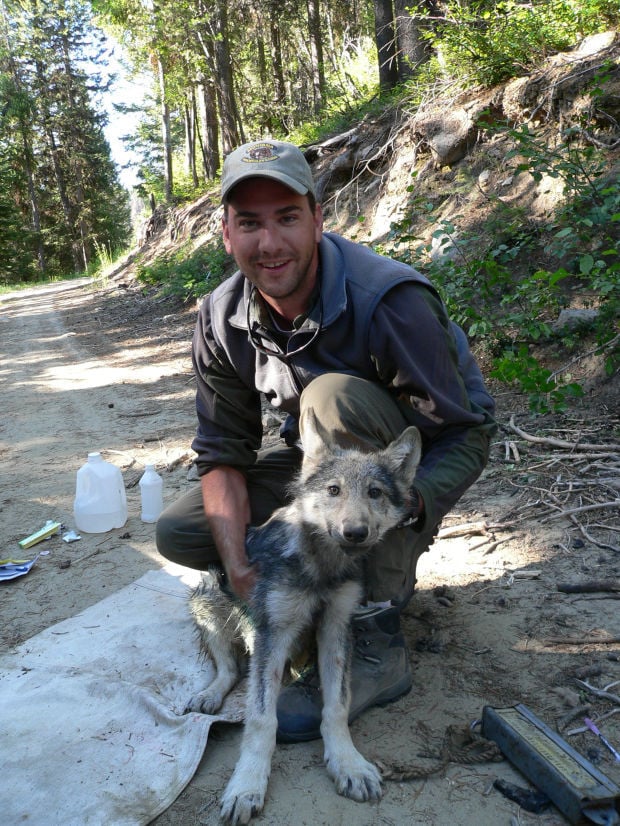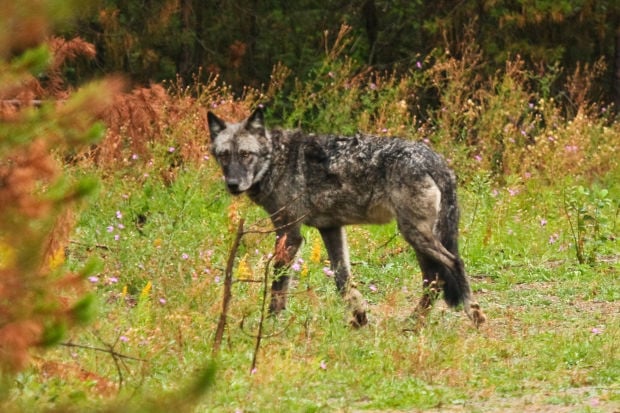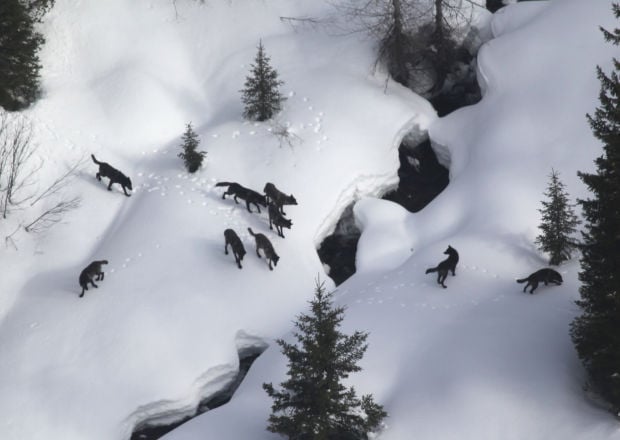Researchers from Montana
Fish, Wildlife and Parks and the University of Montana estimate the
state’s wolf population at more than 800 using a new statistical
technique.
Researchers conducted a study of the new technique from
2007 to 2012. The new method, called patch occupancy modeling, uses
deer and elk hunter observations coupled with information from
radio-collared wolves. The statistical approach is a less expensive
alternative to the old method of minimum wolf counts, which were
performed by biologists and wildlife technicians. The results of the
study estimate that for the five-year period, wolf populations were
25-35 percent higher than the minimum counts for each year. “The
study’s primary objective was to find a less-expensive approach to wolf
monitoring that would yield statistically reliable estimates of the
number of wolves and packs in Montana,” said Justin Gude, FWP’s chief of
research for the wildlife division in Helena.
Counting predators in remote and forested areas is notoriously difficult and expensive. FWP submits a required yearly wolf report to the U.S. Fish and Wildlife Service based on the exact number of wolves observed through tracking by FWP wolf specialists. Biologists track wolves with on-the-ground and aerial surveys, radio collaring and denning confirmation. The minimum count has hovered around 625 for the last three years.
According to a 2012 article in Population Ecology authored by FWP and university researchers, wolf numbers remained small in the initial stages of recovery in the early 1990s, and tracking the minimum count of wolves in Montana meant only a few packs in isolated areas. In 1995, when the U.S. Fish and Wildlife Service reintroduced wolves into Yellowstone National Park and central Idaho, the minimum wolf count in Montana was 66.
With minimum counts now nearly 10 times greater, it’s more difficult to assess the minimum number of wolves. The traditional field methods yield an increasingly conservative count and well below actual population sizes, according to the article. “It takes a lot of people and time, and the budget has gone down with delisting,” Gude said. “It’s getting more and more difficult to keep up, and we felt like we’re getting farther and farther away with the minimum count.”
In two years, FWP’s requirement to provide a yearly minimum count to the Fish and Wildlife Service expires. That expiration opens the door for state officials to use other means to estimate the state’s wolf population.

The agency plans to do both the required minimum count and the patch occupancy modeling for the next two years. After the expiration, FWP plans to transition to the new techniques and adjust field methods of gathering data accordingly, said Ron Aasheim, FWP administrator. “Certainly there have been people out there who said we have significantly more wolves than the minimum count,” he said. “If anything, this verifies that was a minimum count and we don’t have exact numbers; we have trend counts but this gets us closer to the actual number. The more information we have the better.”
Using hunter observations during the five-week general hunting season has the immediate benefit of cost savings and accounts for those wolves not verified in the annual counts. The technique is very similar to wolf counting methods used in the upper-Midwest, which has already withstood court challenges, Gude said. “This new approach is not only good science, it’s a practical way for Montana to obtain a more accurate range of wolf numbers that likely inhabit the state,” he said.
Using the public to count wolves has its drawbacks as biologists consider public sightings less reliable than those of professionals. Given the sample size of around 2 million deer and elk hunter days and 50,000 to 80,000 hunters interviewed in FWP’s annual telephone survey, researchers believe the sample provides a diverse observation of Montana’s hunting districts and provides an accurate picture of wolf occupancy.
Based on the study, FWP and university researchers estimated the areas occupied by wolves in packs using the hunter observations, then the number of wolf packs by dividing the occupied area by average territory size, and finally they multiplied the number of packs by the average pack size to get an estimated population. In 2012, the minimum count for wolves was verified at 625 and 147 packs. The statistical technique estimated 804 wolves in 165 packs inhabit Montana.
The study further estimated that 18, 24 and 25 percent of Montana was occupied by wolves in 2007, 2008 and 2009, respectively.
In addition to wolves living in packs, various studies have documented between 10 and 15 percent of wolves living alone.

The Rocky Mountain Elk Foundation threw its support behind the study with a $25,000 grant. “The bottom line is you can’t have true effective wolf management if you don’t know how many wolves are really out there and where they live,” said David Allen, RMEF president and CEO. “This grant funding will help to better determine that.”
Defenders of Wildlife was still looking at the research and was not ready to comment on the merits of the science, said Erin Edge, Rockies and Plains associate for Defenders.
Wildlife program coordinator for the Greater Yellowstone Coalition Chris Colligan said his organization supports using the best available science, but planned to keep an eye on the use of the new techniques. “We want to make sure it’s accurate and they’re making sound decisions for management,” he said.
The research has been peer reviewed, but GYC has questions about the accuracy of using hunter observations and the ability of that data to apply on a small scale to create individual quotas for hunting districts, Colligan said. “Self-reporting of wolves has its downsides,” he said. “There’s concerns about bias in hunters reporting wolves when they’re not present. It also diminishes the need for biologists on the ground, which is a valuable resource.”
Gude cautioned that future statistical approaches need to include wolf harvest locations and how hunting and trapping influence where wolves choose to live. “Perhaps the best future use of these statistical methods won’t necessarily only be for monitoring and keeping tabs on wolf population numbers, but to better inform the complicated decisions that accompany the public harvest and management of wolves,” he said.
source

Counting predators in remote and forested areas is notoriously difficult and expensive. FWP submits a required yearly wolf report to the U.S. Fish and Wildlife Service based on the exact number of wolves observed through tracking by FWP wolf specialists. Biologists track wolves with on-the-ground and aerial surveys, radio collaring and denning confirmation. The minimum count has hovered around 625 for the last three years.
According to a 2012 article in Population Ecology authored by FWP and university researchers, wolf numbers remained small in the initial stages of recovery in the early 1990s, and tracking the minimum count of wolves in Montana meant only a few packs in isolated areas. In 1995, when the U.S. Fish and Wildlife Service reintroduced wolves into Yellowstone National Park and central Idaho, the minimum wolf count in Montana was 66.
With minimum counts now nearly 10 times greater, it’s more difficult to assess the minimum number of wolves. The traditional field methods yield an increasingly conservative count and well below actual population sizes, according to the article. “It takes a lot of people and time, and the budget has gone down with delisting,” Gude said. “It’s getting more and more difficult to keep up, and we felt like we’re getting farther and farther away with the minimum count.”
In two years, FWP’s requirement to provide a yearly minimum count to the Fish and Wildlife Service expires. That expiration opens the door for state officials to use other means to estimate the state’s wolf population.

A technician with Montana Fish, Wildlife and Parks collars a wolf pup so the agency can track it and check its health. Courtesy photo
The agency plans to do both the required minimum count and the patch occupancy modeling for the next two years. After the expiration, FWP plans to transition to the new techniques and adjust field methods of gathering data accordingly, said Ron Aasheim, FWP administrator. “Certainly there have been people out there who said we have significantly more wolves than the minimum count,” he said. “If anything, this verifies that was a minimum count and we don’t have exact numbers; we have trend counts but this gets us closer to the actual number. The more information we have the better.”
Using hunter observations during the five-week general hunting season has the immediate benefit of cost savings and accounts for those wolves not verified in the annual counts. The technique is very similar to wolf counting methods used in the upper-Midwest, which has already withstood court challenges, Gude said. “This new approach is not only good science, it’s a practical way for Montana to obtain a more accurate range of wolf numbers that likely inhabit the state,” he said.
Using the public to count wolves has its drawbacks as biologists consider public sightings less reliable than those of professionals. Given the sample size of around 2 million deer and elk hunter days and 50,000 to 80,000 hunters interviewed in FWP’s annual telephone survey, researchers believe the sample provides a diverse observation of Montana’s hunting districts and provides an accurate picture of wolf occupancy.
Based on the study, FWP and university researchers estimated the areas occupied by wolves in packs using the hunter observations, then the number of wolf packs by dividing the occupied area by average territory size, and finally they multiplied the number of packs by the average pack size to get an estimated population. In 2012, the minimum count for wolves was verified at 625 and 147 packs. The statistical technique estimated 804 wolves in 165 packs inhabit Montana.
The study further estimated that 18, 24 and 25 percent of Montana was occupied by wolves in 2007, 2008 and 2009, respectively.
In addition to wolves living in packs, various studies have documented between 10 and 15 percent of wolves living alone.

The alpha female of the Cache Creek Pack west of Missoula. Courtesy photo
The Rocky Mountain Elk Foundation threw its support behind the study with a $25,000 grant. “The bottom line is you can’t have true effective wolf management if you don’t know how many wolves are really out there and where they live,” said David Allen, RMEF president and CEO. “This grant funding will help to better determine that.”
Defenders of Wildlife was still looking at the research and was not ready to comment on the merits of the science, said Erin Edge, Rockies and Plains associate for Defenders.
Wildlife program coordinator for the Greater Yellowstone Coalition Chris Colligan said his organization supports using the best available science, but planned to keep an eye on the use of the new techniques. “We want to make sure it’s accurate and they’re making sound decisions for management,” he said.
The research has been peer reviewed, but GYC has questions about the accuracy of using hunter observations and the ability of that data to apply on a small scale to create individual quotas for hunting districts, Colligan said. “Self-reporting of wolves has its downsides,” he said. “There’s concerns about bias in hunters reporting wolves when they’re not present. It also diminishes the need for biologists on the ground, which is a valuable resource.”
Gude cautioned that future statistical approaches need to include wolf harvest locations and how hunting and trapping influence where wolves choose to live. “Perhaps the best future use of these statistical methods won’t necessarily only be for monitoring and keeping tabs on wolf population numbers, but to better inform the complicated decisions that accompany the public harvest and management of wolves,” he said.
source

The
Cache Creek Pack, west of Missoula, is pictured during a wolf counting
flight conducted by Montana Fish, Wildlife and Parks on March 26, 2013. Courtesy photo


No comments:
Post a Comment